DARPA peaceful competitions for military use
DARPA - Agency of advanced defense research projects of the USA - which had a huge impact on the development of new promising technologies. It is believed that thanks to this organization was born the Internet.

The launch in 1957 in the USSR of the first artificial satellite was a rather big surprise. The answer to the satellite was the creation in the United States of ARPA - Advanced Research Projects Agency (the current name of “Advanced Military Research Projects Agency” - DARPA). The goal and motto of DARPA is to “protect against technological surprises for the USA and surprise opponents.”
Agency employees are looking for new technologies and ideas. They do this both independently and through competitions for technical development of innovative ideas (for example, the creation of multispectral video sensors, nano thermal imagers (infrared sensors made on a chip), new types of fuel for starting stages of micro rocket, car-robots and others). One of these contests is the Grand Challenge, the ultimate goal of which is to develop an autonomous combat robot that will perform evacuation and other tasks in a real combat in an autonomous mode.
DARPA Grand Challenge is a robotic car competition sponsored by the US government. The goal of this competition is to create fully autonomous vehicles. The competition is organized by the Pentagon Advanced Defense Development Agency (DARPA). To date, this agency held 3 such competitions (in 2004, 2005 and 2007).
By 2015, the Pentagon plans to replace one-third of its vehicle fleet with robots in order to minimize the risk of human losses in dangerous conditions.
DARPA Grand Challenge 2004
The 240 km (150 miles) route was laid from the city of Barstow (California) to Primm (Nevada) and passed mainly through the Mojave Desert. Cars did not always move along the roads, and on their way there were various artificial and natural obstacles (power lines, tunnels, barbed wire fences, gates, ditches, sandy areas, puddles, stones).

')
The rules set before the participants of the first DARPA Grand Challenge competition were relatively simple: no restrictions on the size and weight of cars, a ban on the participation of people in driving. The maximum time for the passage of the route was 10 hours. In addition, robots should not damage other vehicles, road and natural objects.
Of the 106 teams that applied for participation after the preliminary selection and a series of qualifying races (kilometer obstacle course at California Speedway), 15 were left to participate in the final competition of the DARPA Grand Challenge 2004. The main prize was $ 1 million.
March 13, 2004 the final race took place. 2 hours before the start of the arrival, the participants received a map of the route. Unmanned vehicles had to move along a certain path, marked by the exact coordinates of the nodal points. To set the optimal speed and other parameters for the movement of their robots, teams could study the route in detail by reviewing satellite images, topographic maps and taking photographs from the air.

Out of 15 robots, including an autonomous motorcycle, a buggy, a truck, and a light electric vehicle that were allowed to compete, only eight cars managed to leave the start. Unfortunately, not a single team reached the finish line, the maximum distance that robots were able to overcome was 12 km.
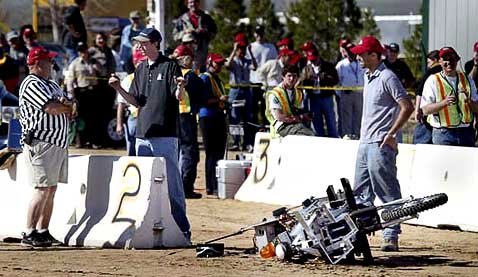
The first autonomous motorcycle fell, having driven only 3 meters
There were plenty of accidents and accidents: one of the vehicles turned over not far from the start, another began to drive in circles, several cars crashed into obstacles, someone got entangled in the barbed wire, someone rolled off the embankment and stalled.
It showed itself well in the preliminary races of the Red Team Sandstorm jeep, and was able to set a speed record among robots - 65 km / h. But, having driven 12 km, he lost his course and, turning around the hill, turned over.

Sandstorm
The prize did not go to anyone ...
DARPA Grand Challenge 2005

Fragment of the DARPA Grand Challenge 2005 track
After about a year and a half, the final competition of the second in a row competition, the DARPA Grand Challenge, took place. The route again passed through the rocky desert of Mojava, its length was 212.5 km (132 miles). And the start and finish was in the city of Primm (Nevada)
The maximum time for arrival was no more than 10 hours. The prize money for the victory was already 2 million dollars. The route, as in the first competition, was issued 2 hours before arrival.
According to the results of the preliminary races, 43 of the 195 teams selected 43. They received an invitation to participate in the NQE (National Qualification Event) - the national qualification selection, which simulated the problems that cars may encounter during the passage of the main route. The NQE was held for 8 days on a small section of the California Speedway 4.5 km long (2.8 miles). According to its results, 23 teams were admitted to the DARPA Grand Challenge 2005 competition.
Before the NQE, each team received a mandatory installation equipment - the E-Stop system (for remotely stopping the vehicle in case of an accident and limiting the maximum speed).

E-Stop System
The final of the DARPA Grand Challenge 2005 competition took place on October 8, 2005. The vehicles had to move in rather difficult conditions (sharp turns, large elevation changes, narrow unlit tunnels, where the loss of the GPS signal occurs, various obstacles on the road). The Stanley vehicle, based on the VW Touareg team of the Stanford Racing Team (Stanford University), won. Stanley was able to overcome the entire route and reach the finish line in 6 hours and 54 minutes. Its average speed was about 30 km / h. The second and third places were shared by the Red Team cars (Carnegie Mellon University).
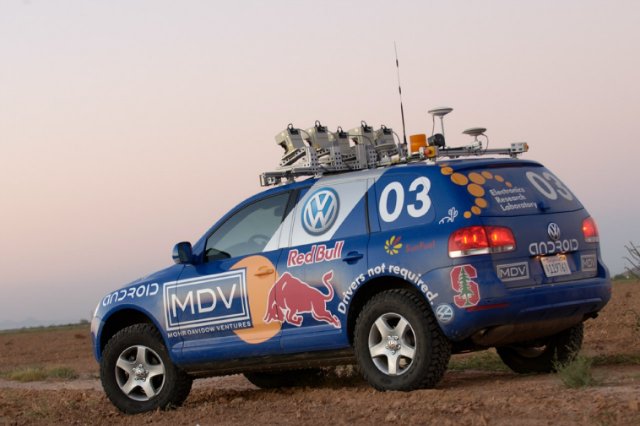
First place - car Stanley
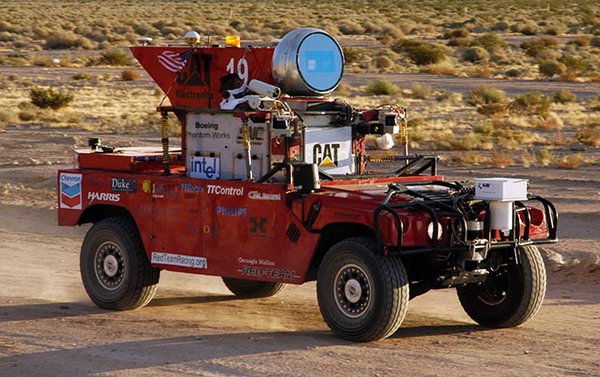
Second place - car Sandstorm
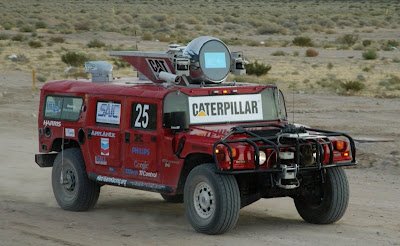
Third place - car H1ghlander
DARPA Urban Challenge 2007
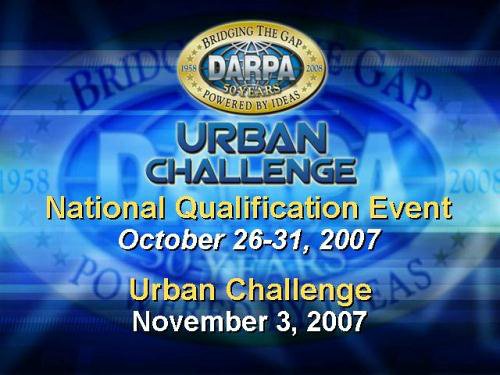
The venue for the next competition was the abandoned George Air Force Base (Northern California). As the name implies, car-robots had to drive a road that no longer passed through the desert, but imitated the streets of a real city with traffic lights, intersections, traffic signs and obstacles (trees, utility wells, and parked cars). The most important condition was the presence of moving vehicles on the track. Robots had to comply with the basic rules of the road, be able to rebuild from one lane to another, enter and move in the stream of other cars and park themselves independently.

DARPA Urban Challenge 2007
The selection mechanism for participation in the final was the same as 2 years ago: teams had to go through 2 types of qualifying qualifying rounds - regional and national (NQE). According to the results of regional qualifying rounds, out of 89 teams, 35 were selected, which received an invitation to participate in the NQE, which was held from October 26 to October 31, 2007. It included testing of unmanned vehicles directly in the conditions of city traffic on a relatively small part of the route - 4.5 km (2.8 miles). Qualification tasks included the passage of intersections, movement in the general flow of other vehicles, detour obstacles, parking, etc. Along with the robots, ordinary people-driven cars moved along the roads.
According to the NQE results, 11 teams were selected for the DARPA Urban Challenge 2007 final. It took place on November 3, 2007. Cars had to deliver the load to the end point, passing 96.5 km (60 miles) through intermediate nodal points (the coordinates of these points were given to the teams 5 minutes before the start). The maximum time allowed for the passage of the route is not more than 6 hours. Collision with other road users or obstacles meant disqualification, and penalty points were awarded for breaking traffic rules. During the race on the "streets" of the landfill, along with the robots, on the road was moving about 50 cars imitating city traffic.
The fastest was the car of the Stanford Racing Team (Stanford University) - Junior. But, taking into account penalty points, in the overall standings he dropped to second place. The first place was received by the Boss car-robot, made on the basis of the Chevrolet Tahoe by the team of Tartan Racing (General Motors Company and Massachusetts Institute of Technology). The third place was taken by the team of FordTango and Ford of the Virginia University of Technology. It is worth noting that for the time allotted by the regulations, 6 robot cars got to the finish line.

First place - car Boss
The prize fund was distributed as follows: first place - $ 2 million, second - 1 million and third - 500 thousand.

Second place - Junior car

Third place - car VictorTango
Participants of the hope of those who wanted to see numerous accidents of robot cars did not materialize, there were only minor incidents, for example, an hour after the start of the competition, the Oshkosh team’s unmanned truck control system failed and was stopped to avoid a collision with one of the landfill buildings. About an hour before the end of the race, two robot cars collided, which did not receive serious damage, but were disqualified, according to the rules of the competition.
Here are some more interesting contests from the agency DARPA.
DARPA Network Challenge

In December 2009, DARPA held a competition to determine the exact coordinates of objects using social networks. His prize was 40 thousand dollars. 10 red balloon-weather balloons were launched into the sky, and after 12 hours they were lowered to the ground. Since during this time the balls scattered throughout the United States and the participants themselves could not determine their coordinates, they were asked to take advantage of the opportunities of social networks. The main purpose of the competition is to understand how the Internet and social networks can help people in organizing cooperation with each other to solve real problems and tasks, it is possible that in the military sphere. The MIT RED BALLOON TEAM team took less than 9 hours to find the coordinates of all 10 balls. They used a viral campaign: each reported the location of the ball relied prize of $ 2000. In this case, a smaller prize was received by a person who brought a friend with the correct data. This allowed to attract a large number of people to search.
Shredder challenge
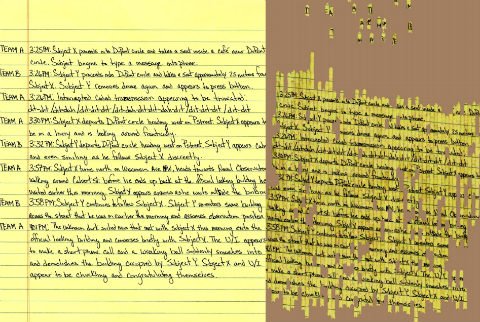
In January 2012, a competition was held to restore shredded documents passed through a shredder.
Participants were issued several documents with handwritten text, which were shredded. Some fragments could be missing in them or be superfluous. It was suggested to answer questions, the answer to which could be learned from these texts. The first place and a prize of 50 thousand dallars went to the San Francisco team with the title "All your pruning belong to the USA." In addition to tracking the spelling of correct combinations of adjacent strips, they used clues scattered around documents, that is, they paid attention to the meaning of the emerging puzzles.
However, the winners clearly showed how a readable text can be obtained from a shredded pile of papers and understood in its sense even with a lack of parts of the document. But this was exactly what the initiators of the competition who represented the interests of the military and special services needed.
Agency DARPA finds new technologies and brings them to the stage of industrial development. One of the principles of the agency is not to be afraid of risk in the hope of an outstanding result. It reports directly to the leadership of the Ministry of Defense, and the staff is only 240 people.
Sources
http://ru.wikipedia.org/wiki/Agency_forward-looking_research_scientific_research_development_US
http://archive.darpa.mil/grandchallenge
http://ru.wikipedia.org/wiki/DARPA_Grand_Challenge

The launch in 1957 in the USSR of the first artificial satellite was a rather big surprise. The answer to the satellite was the creation in the United States of ARPA - Advanced Research Projects Agency (the current name of “Advanced Military Research Projects Agency” - DARPA). The goal and motto of DARPA is to “protect against technological surprises for the USA and surprise opponents.”
Agency employees are looking for new technologies and ideas. They do this both independently and through competitions for technical development of innovative ideas (for example, the creation of multispectral video sensors, nano thermal imagers (infrared sensors made on a chip), new types of fuel for starting stages of micro rocket, car-robots and others). One of these contests is the Grand Challenge, the ultimate goal of which is to develop an autonomous combat robot that will perform evacuation and other tasks in a real combat in an autonomous mode.
DARPA Grand Challenge is a robotic car competition sponsored by the US government. The goal of this competition is to create fully autonomous vehicles. The competition is organized by the Pentagon Advanced Defense Development Agency (DARPA). To date, this agency held 3 such competitions (in 2004, 2005 and 2007).
By 2015, the Pentagon plans to replace one-third of its vehicle fleet with robots in order to minimize the risk of human losses in dangerous conditions.
DARPA Grand Challenge 2004
The 240 km (150 miles) route was laid from the city of Barstow (California) to Primm (Nevada) and passed mainly through the Mojave Desert. Cars did not always move along the roads, and on their way there were various artificial and natural obstacles (power lines, tunnels, barbed wire fences, gates, ditches, sandy areas, puddles, stones).

')
The rules set before the participants of the first DARPA Grand Challenge competition were relatively simple: no restrictions on the size and weight of cars, a ban on the participation of people in driving. The maximum time for the passage of the route was 10 hours. In addition, robots should not damage other vehicles, road and natural objects.
Of the 106 teams that applied for participation after the preliminary selection and a series of qualifying races (kilometer obstacle course at California Speedway), 15 were left to participate in the final competition of the DARPA Grand Challenge 2004. The main prize was $ 1 million.
March 13, 2004 the final race took place. 2 hours before the start of the arrival, the participants received a map of the route. Unmanned vehicles had to move along a certain path, marked by the exact coordinates of the nodal points. To set the optimal speed and other parameters for the movement of their robots, teams could study the route in detail by reviewing satellite images, topographic maps and taking photographs from the air.

Out of 15 robots, including an autonomous motorcycle, a buggy, a truck, and a light electric vehicle that were allowed to compete, only eight cars managed to leave the start. Unfortunately, not a single team reached the finish line, the maximum distance that robots were able to overcome was 12 km.

The first autonomous motorcycle fell, having driven only 3 meters
There were plenty of accidents and accidents: one of the vehicles turned over not far from the start, another began to drive in circles, several cars crashed into obstacles, someone got entangled in the barbed wire, someone rolled off the embankment and stalled.
It showed itself well in the preliminary races of the Red Team Sandstorm jeep, and was able to set a speed record among robots - 65 km / h. But, having driven 12 km, he lost his course and, turning around the hill, turned over.

Sandstorm
The prize did not go to anyone ...
DARPA Grand Challenge 2005

Fragment of the DARPA Grand Challenge 2005 track
After about a year and a half, the final competition of the second in a row competition, the DARPA Grand Challenge, took place. The route again passed through the rocky desert of Mojava, its length was 212.5 km (132 miles). And the start and finish was in the city of Primm (Nevada)
The maximum time for arrival was no more than 10 hours. The prize money for the victory was already 2 million dollars. The route, as in the first competition, was issued 2 hours before arrival.
According to the results of the preliminary races, 43 of the 195 teams selected 43. They received an invitation to participate in the NQE (National Qualification Event) - the national qualification selection, which simulated the problems that cars may encounter during the passage of the main route. The NQE was held for 8 days on a small section of the California Speedway 4.5 km long (2.8 miles). According to its results, 23 teams were admitted to the DARPA Grand Challenge 2005 competition.
Before the NQE, each team received a mandatory installation equipment - the E-Stop system (for remotely stopping the vehicle in case of an accident and limiting the maximum speed).

E-Stop System
The final of the DARPA Grand Challenge 2005 competition took place on October 8, 2005. The vehicles had to move in rather difficult conditions (sharp turns, large elevation changes, narrow unlit tunnels, where the loss of the GPS signal occurs, various obstacles on the road). The Stanley vehicle, based on the VW Touareg team of the Stanford Racing Team (Stanford University), won. Stanley was able to overcome the entire route and reach the finish line in 6 hours and 54 minutes. Its average speed was about 30 km / h. The second and third places were shared by the Red Team cars (Carnegie Mellon University).

First place - car Stanley

Second place - car Sandstorm

Third place - car H1ghlander
DARPA Urban Challenge 2007

The venue for the next competition was the abandoned George Air Force Base (Northern California). As the name implies, car-robots had to drive a road that no longer passed through the desert, but imitated the streets of a real city with traffic lights, intersections, traffic signs and obstacles (trees, utility wells, and parked cars). The most important condition was the presence of moving vehicles on the track. Robots had to comply with the basic rules of the road, be able to rebuild from one lane to another, enter and move in the stream of other cars and park themselves independently.

DARPA Urban Challenge 2007
The selection mechanism for participation in the final was the same as 2 years ago: teams had to go through 2 types of qualifying qualifying rounds - regional and national (NQE). According to the results of regional qualifying rounds, out of 89 teams, 35 were selected, which received an invitation to participate in the NQE, which was held from October 26 to October 31, 2007. It included testing of unmanned vehicles directly in the conditions of city traffic on a relatively small part of the route - 4.5 km (2.8 miles). Qualification tasks included the passage of intersections, movement in the general flow of other vehicles, detour obstacles, parking, etc. Along with the robots, ordinary people-driven cars moved along the roads.
According to the NQE results, 11 teams were selected for the DARPA Urban Challenge 2007 final. It took place on November 3, 2007. Cars had to deliver the load to the end point, passing 96.5 km (60 miles) through intermediate nodal points (the coordinates of these points were given to the teams 5 minutes before the start). The maximum time allowed for the passage of the route is not more than 6 hours. Collision with other road users or obstacles meant disqualification, and penalty points were awarded for breaking traffic rules. During the race on the "streets" of the landfill, along with the robots, on the road was moving about 50 cars imitating city traffic.
The fastest was the car of the Stanford Racing Team (Stanford University) - Junior. But, taking into account penalty points, in the overall standings he dropped to second place. The first place was received by the Boss car-robot, made on the basis of the Chevrolet Tahoe by the team of Tartan Racing (General Motors Company and Massachusetts Institute of Technology). The third place was taken by the team of FordTango and Ford of the Virginia University of Technology. It is worth noting that for the time allotted by the regulations, 6 robot cars got to the finish line.

First place - car Boss
The prize fund was distributed as follows: first place - $ 2 million, second - 1 million and third - 500 thousand.

Second place - Junior car

Third place - car VictorTango
Participants of the hope of those who wanted to see numerous accidents of robot cars did not materialize, there were only minor incidents, for example, an hour after the start of the competition, the Oshkosh team’s unmanned truck control system failed and was stopped to avoid a collision with one of the landfill buildings. About an hour before the end of the race, two robot cars collided, which did not receive serious damage, but were disqualified, according to the rules of the competition.
Here are some more interesting contests from the agency DARPA.
DARPA Network Challenge

In December 2009, DARPA held a competition to determine the exact coordinates of objects using social networks. His prize was 40 thousand dollars. 10 red balloon-weather balloons were launched into the sky, and after 12 hours they were lowered to the ground. Since during this time the balls scattered throughout the United States and the participants themselves could not determine their coordinates, they were asked to take advantage of the opportunities of social networks. The main purpose of the competition is to understand how the Internet and social networks can help people in organizing cooperation with each other to solve real problems and tasks, it is possible that in the military sphere. The MIT RED BALLOON TEAM team took less than 9 hours to find the coordinates of all 10 balls. They used a viral campaign: each reported the location of the ball relied prize of $ 2000. In this case, a smaller prize was received by a person who brought a friend with the correct data. This allowed to attract a large number of people to search.
Shredder challenge

In January 2012, a competition was held to restore shredded documents passed through a shredder.
Participants were issued several documents with handwritten text, which were shredded. Some fragments could be missing in them or be superfluous. It was suggested to answer questions, the answer to which could be learned from these texts. The first place and a prize of 50 thousand dallars went to the San Francisco team with the title "All your pruning belong to the USA." In addition to tracking the spelling of correct combinations of adjacent strips, they used clues scattered around documents, that is, they paid attention to the meaning of the emerging puzzles.
However, the winners clearly showed how a readable text can be obtained from a shredded pile of papers and understood in its sense even with a lack of parts of the document. But this was exactly what the initiators of the competition who represented the interests of the military and special services needed.
Agency DARPA finds new technologies and brings them to the stage of industrial development. One of the principles of the agency is not to be afraid of risk in the hope of an outstanding result. It reports directly to the leadership of the Ministry of Defense, and the staff is only 240 people.
Sources
http://ru.wikipedia.org/wiki/Agency_forward-looking_research_scientific_research_development_US
http://archive.darpa.mil/grandchallenge
http://ru.wikipedia.org/wiki/DARPA_Grand_Challenge
Source: https://habr.com/ru/post/144314/
All Articles